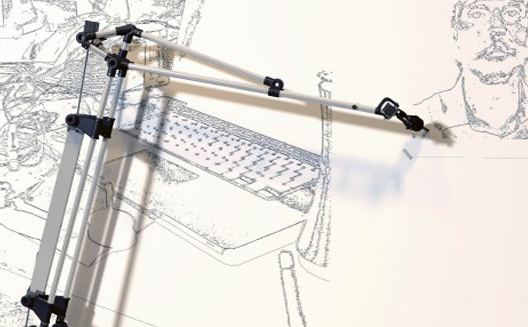Former Lebanese bakery serves up innovation


The Obsessive Drafter hard at work. (Image via
theBakery)
Let’s head to theBAKERY, a cozy design lab in Beirut's Mar Mikhael neighborhood that draws its unorthodox name and a few of its other characteristics from the bake shop it once was.
Baked goods are no longer produced here. What is created instead is far more innovative.
This design lab houses RapidManufactory, the Middle East’s first 3D printing and rapid manufacturing shop. It was launched in April 2013 by Guillaume Crédoz, a French multidisciplinary architect.
3D printing is also known as “additive manufacturing”, whereby a solid object is built based on a digital model. 3D printers add successive layers of specific materials such as natural polyamide and brass until an entire object is crafted. The technology dates back to 1984 when Chuck Hull, cofounder of 3D Systems, created the first ever 3D printer. But it wasn’t until 2010 that the technology began to scale.
“There is not really one market [for it], it's a very versatile tool, so it can be used in many domains,” Crédoz said.

Guillaume Crédoz. (Image via
RapidManufactory)
The magic of machinery
RapidManufactory uses a blend of different technologies to produce its goods.
“We mainly use three 3D printers, the preferred one being the SLS (Selective Laser Sintering), because it's fast, precise, doesn't require any support and can produce objects of any complexity, including mechanical joints, hinges and gear systems,” Crédoz said.
The second 3D printer is mainly used in the creation of RapidManufactory’s eyewear collection - including its plant-based eyewear frames, which earned the design lab the distinction of being the first eyewear manufacturer in Lebanon.
“It is a printer that can solidify a lot of materials, like the 100 percent plant-based polyamide 11 that we use for the eyewear we design and manufacture,” Crédoz said.
“There is also a third 3D printer for which we engineered some powders ourselves, like the glow in the dark and our unique concrete powder with which we broke some world records including the smallest and most precise object ever done in concrete and the first eyewear in concrete,” he added.
The Obsessive Drafter

The Obsessive Drafter. (Image via
RapidManufactory)
Crédoz is also working on more abstract projects. Last year he teamed up with Nareg Karaolaghnian, a fluid mechanics engineer currently teaching at the American University of Beirut, for The Obsessive Drafter, RapidManufactory’s one-off tech-art project.
The Obsessive Drafter is a sleek and thin robotic arm with a large graphite pencil that draws frescoes and live portraits on a seven-meter wall non-stop.
Built from scratch over two months, The Obsessive Drafter resembles a human arm. This personification was a key component of the project.
They unveiled The Obsessive Drafter at Design Days Dubai 2014, a design fair dedicated to collectible and limited edition furniture and designs.
Nobody could fully anticipate its output due to the complexity of the commands the machine is able to process.
“We want people to project thought into the machine and be curious of what the machine is thinking,” Crédoz said.
Visitors could interrupt the machine while it was completing its initial large-scale drawing, to have it draw their portraits on the spot. When they were within range of the sensors sensors, The Obsessive Drafter would snap their picture and turn it into vectors. It completed three live portraits at the exhibition.
Crédoz has conceived many ways to play around with the installation. “We are currently looking for another invitation in order to move on to the next generation of it, with a lot of enhancements,” he told Wamda.
A perpetually evolving business

A flock of 3D printed sheep. (Image via
RapidManufactory)
RapidManufactory is also establishing itself as a toy manufacturer. It has developed QalamSila, a construction toy that combines conventional pencils with 3D printed connectors. It has also piqued the attention of investors.
“As we caught the intention of some investors, we will continue to grow and strengthen our Research & Creation department,” Crédoz added. “The variety of people working here, their cross-platform capacities, and our constant jumps from digital to analog are the strengths of RapidManufactory.”
The evolution, dynamics and expandability of RapidManufactory’s creative process are just inspiring. A few minutes spent at the shop could restore one’s faith in Beirut’s creative potential and gives you hope in a brighter future for the country. Maybe it’s time for you to throw in your own ideas and join the design jam.


